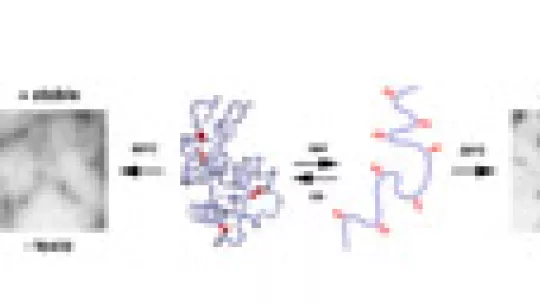Images
Scientists at IRB Barcelona and the BSC discover that some proteins have chemical bonds that prevent the formation of toxic aggregates.
The study sheds light on how proteins have evolved to prevent the cell toxicity associated with toxic aggregates.
Researchers headed by Xavier Salvatella, ICREA researcher with the joint program between the Institute for Research in Biomedicine (IRB Barcelona) and the Barcelona Supercomputing Center (BSC), have discovered that certain bonds that keep proteins folded, called disulfide bridges, induce the formation of protein aggregates that are more stable and less toxic for cells than those that don’t have them. According to these scientists, these results would explain the greater presence of these bonds in proteins secreted extracellularly, an environment in which they aggregate more easily. Involving collaboration with researchers at the “Centre de Regulació Genòmica de Barcelona”, the University of Cambridge (UK) and the University of Liège (Belgium), the study has come out in Angewandte Chemie, one of the most prestigious international journal of chemistry.
In many diseases, including Parkinson’s and Alzheimer’s, cell death is probably related to the build up of protein aggregates that take the form of amyloid fibers. “In spite of the relevance of these deposits, little is known about why they are toxic, about why some fibers are more toxic than others, or about the mechanisms through which these fibers damage cells. One of the research interests of our lab is to study these processes”, explains Salvatella.
Chemical bonds to prevent cell death
Disulfide bonds are found in 65% in proteins secreted by cells into the extracellular environment and in some proteins that form these deposits. “We decided to study the role of these bonds in aggregation. In order to do so, we removed them and studied the morphology and toxicity of the fibers that proteins can form”, says Salvatella.
When the researchers removed these bonds from a model protein called lisozyme, they observed an expected increase in the amount of aggregates but “surprisingly, the proteins that had disulfide bonds formed more structured fibers. These were more stable and less toxic than those that did not have these bonds”. Computational analysis showed that these bonds are a common denominator in proteins with a tendency form aggregates and not a specific feature of a small number of proteins.
But why are these bonds beneficial? According to the study, they reduce the risk of fiber formation, and if they do develop, the fibers appear as less damaging. “Because the fibers are more structured than those that do not have these bonds, it could be more difficult for them to have a negative effect on other cellular components; another possible explanation is that because these fibers are more stable, it is more difficult for them to break up into small fragments, which are potentially highly toxic”. It appears that these protein bonds could have evolved to safeguard cells against death.
Reference article:
Disulfide bonds reduce the toxicity of the amyloid fibrils formed by an extracellular protein.
Maria F. Mossuto, Benedetta Bolognesi, Bernat Guixer, Anne Dhulesia, Federico Agostini, Janet R. Kumita, Gian G. Tartaglia, Mireille Dumoulin, Christopher M. Dobson, and Xavier Salvatella.
Angew. Chem. Int. Ed. (2011). [doi: 10.1002/anie.201100986].
About IRB Barcelona
The Institute for Research in Biomedicine (IRB Barcelona) pursues a society free of disease. To this end, it conducts multidisciplinary research of excellence to cure cancer and other diseases linked to ageing. It establishes technology transfer agreements with the pharmaceutical industry and major hospitals to bring research results closer to society, and organises a range of science outreach activities to engage the public in an open dialogue. IRB Barcelona is an international centre that hosts 400 researchers and more than 30 nationalities. Recognised as a Severo Ochoa Centre of Excellence since 2011, IRB Barcelona is a CERCA centre and member of the Barcelona Institute of Science and Technology (BIST).





